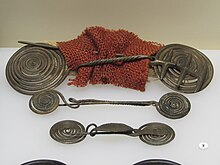Spiral plate brooch

The golden spiral plate fibula with a cross-notched bow in which both wire ends were wound into spirals (there are also one-sided from Southeast Europe), from the Bronze Age is currently known in 9 copies, mainly from Schleswig-Holstein or North Jutland .
The most recent comes from a sword grave from period IIII (1300–1100 BC) on a hilltop near Crivitz ( Ludwigslust-Parchim district ) and lay on a predominantly single-layer stone packing with centrally sunk stones. The intact fibula - like almost all comparative pieces - did not have a needle. In Beetzsee ( Potsdam-Mittelmark district ), arm and finger rings as well as spiral plate brooches and helical rings were found in the urn grave field on Black Mountain as early as the 19th century .
In 2008, a bronze handle-tongue sword and a twisted gold bracelet with a wound gold wire spiral were found on the crest of the terrain near Crivitz. Similar to the gold arm ring, gold spiral plate fibulae often come from sword graves and are primarily to be seen as status symbols.
The bronze spiral plate fibula from Magdeburg- Salbke belongs to the barrow culture at around the same time , in which fibulae for closing clothes appeared for the first time . Burial in burial mounds is characteristic of this culture, whose main area of distribution was Thuringia and the Main and Danube regions.
literature
- H. Lies: excavator finds from the Elbe gravel works Magdeburg-Salbke . In: Annual Journal for Central German Prehistory 47, 1963, pp. 101–120.
- A. Pietzsch: Technical remarks on the spiral plate primers from Saxony. For the faithful reconstruction of the Göttwitzer fibula and an old replica of the fibula by Obergurig . In: Work and research reports on Sächsische Bodendenkmalpflege 16/17, 1967, pp. 105–127.
- Mechthild Schulze-Dörrlamm: Germanic spiral plate brooches or Romanic bow brooches? To the models of Elbe-Germanic-Franconian bow brooches from the Protomerovingian period. In: Archäologisches Korrespondenzblatt 30, 2000, pp. 599–613.